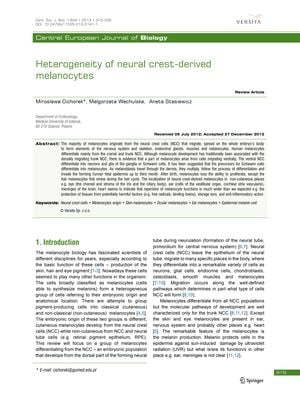Heterogeneity of Neural Crest-Derived Melanocytes
February 2013
in “
Central European Journal of Biology
”

TLDR Melanocytes are diverse cells important for pigmentation and skin health, influenced by genetics and environment.
The document from April 1, 2013, reviews the complexity of melanocytes, which are pigment-producing cells derived from neural crest cells. It covers their embryonic development, migration, differentiation, and the molecular pathways involved, such as Wnt proteins and MAPK signaling. The review also discusses the diverse functions of melanocytes beyond pigment production, including their roles in the immune system and presence in various non-cutaneous locations. Melanocyte Inducing Transcription Factor (MITF) is identified as a crucial regulator of melanocyte biology, influencing their proliferation, differentiation, and survival. The process of melanogenesis is described as cytotoxic, necessitating protective measures like increased BCL-2 levels. The document notes that melanocyte numbers decrease with age, and their activity is influenced by genetic and environmental factors. The transfer of melanosomes to keratinocytes and the interactions between melanocytes, keratinocytes, and fibroblasts are important for skin pigmentation and homeostasis. Lastly, the review acknowledges the neuroendocrine capabilities of melanocytes and their significance for skin health.







